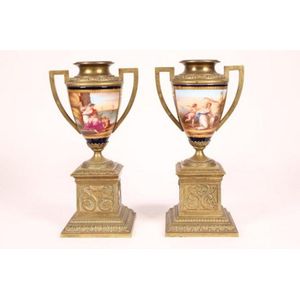Ormolu Mounted Sevres Style Covered Vases
You must be a subscriber, and be logged in to view price and dealer details.
Subscribe Now to view actual auction price for this item
When you subscribe, you have the option of setting the currency in which to display prices to $Au, $US, $NZ or Stg.
- A/f, as Inspected - The letters "A/F" or "as inspected" as part of a description is the cataloguer's shorthand for "all faults" or "as found", meaning the item has some type of damage or deficiency, it is of uncertain date or provenance, and/or that the seller takes no responsibility for the completeness of the item or the accuracy of the description.
- Finial - An architectural decoration, found on the upper parts of of an object. On furniture they are usually found on pediments, canopies and shelf supports. On smaller ceramic or silver items, such as spoons, they may decorate the top of the item itself, or the lid or cover where they provide a useful handle for removal.
Finials have a variety of shapes and forms. They may be urn-shaped, baluster shaped round or spiral, but usually taper into an upper point. Many real life shapes may also be used as finials, such as pineapples, berries, pinecones, buds, lotus and acorns. Sometimes animals such as a lion are depicted, or fish and dolphins. - Ormolu - Ormolu was popular with French craftsmen in the 18th and 19th century for ornamental fittings for furniture, clocks and other decorative items. True ormolu is gilt bronze, that is bronze that has been coated with gold using a mercury amalgam. Due to the health risks associated with using mercury, this method of creating ormolu was discontinued in France in the 1830s. A substitute was developed consisting of about 75% copper and 25% zinc, however it was inferior to the bronze version. It was often lacquered to prevent it tarnishing.
This item has been included into following indexes:
-
Sevres (France) and Sevres style, items
- house wares 275
- vases and urns 224
Visually similar items

A pair of Sevres baluster form bronze mounted vases and covers, French, 19th century, finely decorated throughout with classical figures on a deep blue and gold ground, 62 cm high

Pair 19th century Royal Vienna twin handled urns and covers, painted with classical figures and cupids, on a cobalt ground, set with ormolu mounts on a stepped base, height 20 cm

Murano glass decanter & 8 matching glasses

Pair of old Paris Porcelain vases, late 19th century, each with two scrolled mask handles, the body painted with a seascape against a burgundy ground further embellished with gilded foliage, marked 'B. S. & Cie Paris' (2), height 35 cm. Provenance: Private
